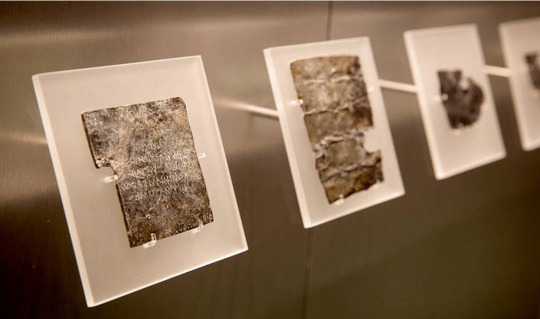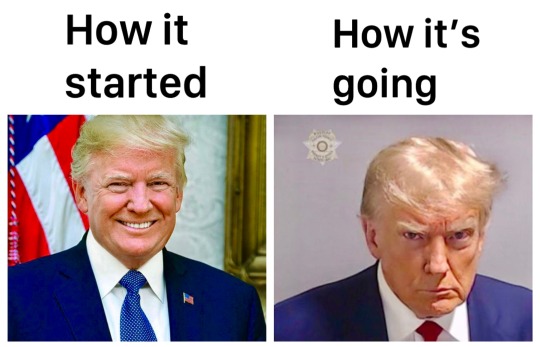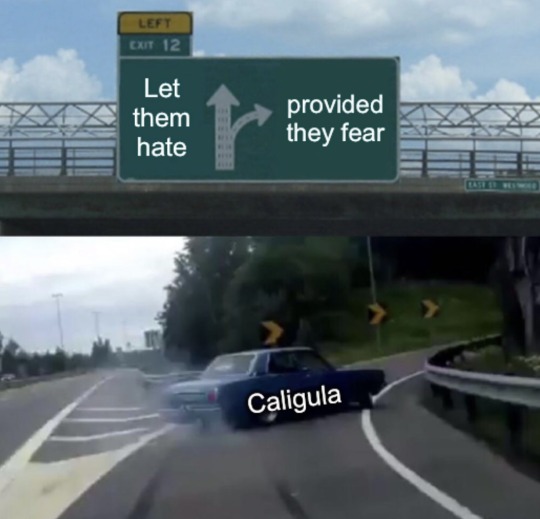#funny history
Text

2K notes
·
View notes
Text
The Ea-Nasir meme reminds me of how in Bath, England, there's the famous Roman Baths. If you ever visit, they have displays of all these prayer tablets that were found in the spring of the goddess Sulis Minerva, where people tossed them into the waters to ask for aid.

And like, 90% of the ones I remember being on display went something like:
"Someone stole my cloak while I was bathing and I would like you to punish them with blood and plague unless it is returned by Thursday"
"Please place a curse upon Bob, who took my gloves while I was bathing, thank you"
"I lost six silver coins in the baths and it was definitely stolen by either Steve or Joe or Peter, please bring your divine wrath upon the head of either Steve or Joe or Peter for this terrible deed"
Because people have always been people, and we have always needed a way to complain about the petty daily bullshit we have to put up with
(You can read more of them here on Wikipedia)
403 notes
·
View notes
Text
Alcibiades would like a word

#not only did i steal thid from facebook but I made the same joke bc im so haha hilarious#socrates#classics#tagamemnon#funny history#alcibiades#cricket chirps
122 notes
·
View notes
Text

#funny#hilarious#funniest#funny images#hilarious picture#funnymemes#funniest memes#new memes#history meme#funny history#trump indictment#donald trump#former president#republicans#right wing idiots#ultimate impostor
158 notes
·
View notes
Text

Molotov Cocktails, a perfect drink to wash down those Russian troops with!😂
🇫🇮🔥🇺🇦
#history#molotov cocktail#finland#soviet union#russia#military history#vyacheslav molotov#dark humor#russo finnish war#ww2#propaganda#ukraine war#finnish history#funny history#spanish civil war#scandinavia#the winter war#russian history#military#ussr#world war 2#resistance#nickys facts
68 notes
·
View notes
Text
Having a history major best friend is the BEST. Because sometimes she just tells me some of the most hilarious history facts, like about the one Russian man who had GOVERNMENT APPROVAL to have gay sex, because he had gotten shot in the dick, and couldn’t have any other kind of sex. Like that is better than any comedy every made.
36 notes
·
View notes
Text

• Operation: Body Snatch
Operation Body Snatch, which began on April 27th of 1945, just three days before Adolf Hitler’s suicide, was an operation by U.S forces to return the remains of Germany’s most celebrated rulers: King Frederick Wilhelm I, King Frederick the Great, and Field Marshall Paul von Hindenburg. To their proper burial locations.
On The 27th of April, seven members of the U.S. Army Ordnance Corp were searching the northern reaches of Germany’s Thuringian Forest – basically the middle of nowhere - for hidden ammo dumps. That is when they stumbled across a salt mine in Bernterode that had been used as a munitions manufacturing and storage facility. The size of this mine, that one reached it by taking an elevator down about 1800 feet – that’s about a 1/3 of a mile or ½ a kilometer from the surface. Down there, the men found an estimated 400,000 tons of stored ammo in its estimated 14 miles or 23 kilometers of tunnels. However there was an ever bigger surprise in store for them. About 1/4 of a mile or 4/10 of a kilometer from the elevator shaft, the soldiers stumbled across a side passageway that appeared to be sealed off with fresh cement. They decided to find out what was behind that newly mortared wall. They tunneled an opening through an estimated 6-feet or 2-meters of masonry and rubble.
It was a room that had been partitioned off into bays that were filled with artwork, boxes, and tapestries. An estimated 225 Prussian flags and banners were hanging unfurled. More importantly, everything surrounded four coffins, one of which was adorned with a large wreath and red ribbons with swastikas and bore the name Adolph Hitler. Upon closer inspection, they noticed that someone had quickly scribbled a few words in red crayon on each casket. Three of these were the remains of Germany’s most celebrated rulers: King Frederick Wilhelm I, King Frederick the Great, and Field Marshall Paul von Hindenburg. The fourth casket belonged to Frau von Hindenburg. These remains had been placed down in the mine about three weeks earlier as the Russians were closing in on Potsdam, the location of the Tannenberg Memorial. The Nazis feared that the Russians would destroy not just the monument, but also the remains that were buried there – those of Hindenburg and his wife. They quickly removed the caskets and blew up the remaining sarcophagi, ultimately finding their way, along with the two Fredericks, to the Bernterode mine.
It has been theorized that this room deep in the mine was set up to preserve the most precious artifacts of German military history for the next rise of the German Reich. The job of getting these four coffins and all of the associated regalia up and out of the mine became the responsibility of the MFA&A – or the Monuments, Fine Arts, & Archives – branch of the military. This was a group of 345 art historians, museum directors, architects, educators, and curators that hailed from thirteen different countries. Better known today as the Monuments Men. The coffins were the last objects to be removed from the mine. Frau von Hindenburg had the lightest casket and was the first one to take the fourteen minute ride up to the surface. Next was Frederick Wilhelm I, followed by Field Marshall von Hindenburg. The last coffin, however, was not going to return to the surface easily. Frederick the Great’s casket was massive and weighed over half-a-ton. In addition to being incredibly difficult to maneuver. To the surprise of the men accompanying Frederick the Great on his journey skyward, as they approached the surface they could hear a radio blasting the Star Spangled banner followed by God Save the King. Germany had just surrendered the war.
These four caskets created an incredible dilemma for the US Army. Three of these four caskets belonged to men that played a significant role in Germany’s military history. They couldn’t be reburied in just any ordinary way. On the other hand, to give each a grand burial with an ornate tombstone or monument could help bring the Nazi party back to life. So, the Army without certainty of what to do with the caskets quickly passed the responsibility on to the higher-ups in Washington, DC to deal with. Since the US government was dealing with the bodies of dignitaries, the issue was deferred to the State Department, the branch of our government that deals with international relations. For an entire year the coffins didn’t move from their guarded storage location in the basement of a castle in Marburg. Ultimately, it was decided that these bodies were of historical importance and should be treated just like any other historical treasure or artwork plundered during the war. This top secret reinternment of the bodies once again became the responsibility of the Monuments Men.
Three officers were assigned: Theodore Heinrich, Francis Bilodeau, and Everett Lesley Jr. It was Lesley that coined the name of this top secret mission: Operation Body Snatch. Their instructions were fairly straightforward. The two kings were to be reburied in the US controlled zone Greater Hesse, while the two Hindenburgs were to be buried near Hanover in the British Zone. Why Hanover? That’s because Hindenburg had requested that he be buried on his family plot there. It was Hitler who decided to override his final wishes and have his remains placed at the Tannenberg Memorial. The US was simply trying to respect Hindenburg’s wishes, but it was not to be. The British government wanted nothing to do with the bodies. Word came back from London that would not allow the bodies into their zone under any condition. So, they couldn’t be buried in the British or French zones. It became clear that all four bodies needed to be buried somewhere in the US zone. Since all four of these corpses were of the Protestant faith, it seemed logical to bury them in a Protestant church. That idea quickly fizzled after it was determined that all of the suitable Protestant churches were either badly damaged or totally destroyed in the war. The next step of the three Monuments men was to see if they could find a place, any place, that had even a slight connection to the Hohenzollern family. After careful research, the Kronberg castle near Frankfurt seemed like the perfect fit. Once again, luck was not on their side. The Monuments Men, Theodore Heinrich in particular, had a bigger problem thrown on their plate. Someone had stolen the jewels that had been hidden in the Kronberg castle. Valued at $7.6 million dollars in 1947 or about $77 million today, the great mystery of the theft focused worldwide attention on the castle.
Ultimately, the answer they had been seeking was hidden right under their noses: St. Elizabeth’s church in Marburg. The church had survived the war in good shape and lie just a few hundred yards from where the bodies were currently being stored. But, the real question was whether or not the church had any space left to bury the bodies. The three officers spent a considerable amount of time searching through the church’s burial records to locate possible burial spots. It was decided that the two Fredericks would be buried below the floor of the north transept, while the Hindenburgs would find final rest at the base of its north tower. Before moving forward with their plan, descendants of both families were consulted to seek their approval. The French would not allow Crown Prince Wilhelm, the eldest son of Germany’s last Emperor, to leave their zone, so a letter notifying him that his eldest daughter Cecilia. Getting Hindenburg family approval didn’t go smoothly either. They were to meet his only son Oskar in Wiesbaden, but he was a no-show. It turns out that he had been arrested by American security police for signing a Wiesbaden hotel register with his full military title. Once released, Hindenburg was taken to St. Elizabeth’s and granted his family’s approval for the reburial plan. The four bodies were finally laid to rest on August 19th of 1946, 479 days after they were first discovered deep down in that Thuringian mine. There was fear that fanatics may want to steal the bodies, so the graves were covered with steel plates and a layer of concrete. In September of 1952, the caskets of the two kings were moved once again. This time they were taken to Hohenzollern Castle in Hechingen where a family spokesman declared they were to remain “until Germany is united again and they can return to Potsdam.” When the Berlin Wall fell in 1989, the decision was made to do just that. On August 17th of 1991, the 205th anniversary of Frederick the Great’s death, they were interred one last time.
#ww2#world war 2#second world war#world war ii#wwii#history#spooky#germany#german history#monuments men#funny history#military history
219 notes
·
View notes
Text

#ancient history#caligula#ancient rome#historical#history#funny history#funny quotes#memes#history memes#history jokes#famous quotes#historical quotes#roman memes#roman emperor#roman empire
73 notes
·
View notes
Text
The more you learn about history, the more you learn about how big of an issue smoking was, as there is no way some of those choices could’ve been approved if people weren’t high
26 notes
·
View notes
Text
I have never related to literature more…
Helmer: …Nora, guess what I have here.
Nora: (*turning quickly*) Money!
-Henrik Ibsen, “A Doll House.” (Act I, Lines 24-25)
#academia#chaotic academia#dark academia#classic academia#literature#uni#quote#book#college#english literature#funny literature#funny quotes#funny history#money#I love money#English#read#reading#writer#write#play#playwright#act#scene#a doll house#henrik ibsen#ibsen#poem#poet#relateable
33 notes
·
View notes
Text
Me, playing my dwarven cleric: The people back home seem to believe if women sit on trains, they lose their uterus from between their legs.
The group, collectively: *chuckling because that's crazy*
Me, OOC: no like that was an actual thing that happened in irl history *posts link*
The group: *collectively losing their shit*
The random factoids from history strike again!
21 notes
·
View notes
Text

74 notes
·
View notes
Text
Never forget when Oscar Wilde was accused of homosexuality and his novel “the portrait of Dorian grey” was put up as evidence due to “homoerotic subtext” and he more or less told everyone “I’m not gay, you’re gay”
#the portrait of dorian gray#oscar wilde#queer history#funny history#read the prelude and tell me that isn’t what it says
80 notes
·
View notes
Text

Lol. Lmao
#Marie Louise#Josephine#Napoleon#Parquin#napoleonic era#napoleonic#funny history#history#french history
17 notes
·
View notes
Text
So I’m aware this is not the kind of stuff I normally post but I just wanted to share this knowledge with you because I think it’s amazing. So right in Dublin City centre there’s this park called Stephens Green. And it’s a relatively normal looking park next to tonnes of shops. But in the year 1916 it was the site of one of the biggest conflicts in the Easter/1916 Rising in which some Irish Republican paramilitaries (not the IRA they didn’t exist yet) tried to overthrow British rule in Ireland and get a republic so Irish people could run their own affairs. It’s one of the most significant events in Irish history because, though it was an utter military failure due to frankly ridiculously small numbers and firearms, it is seen as one of the defining events that led to our independence in 1921 after the war of independence.
So during this conflict the rebels took over the park due to its location in the city centre. They barricaded the gates and dug trenches. This was called the battle of St Stephens Green. The British soldiers were lined up outside surrounding it with guns and the conflict raged on for days with several civilians as well as members of both parties being killed and injured.
But during this one groundskeeper by the name of James Kearney decided he had higher priorities. Twice a day the Irish Citizens Army and Cumann na mBan (two Irish military forces that i feel it should be mentioned that the former allowed women operate on the same level as men within its ranks and the latter was solely comprised of women though much smaller) called a truce with the British army so that he could feed the ducks. Yes you read that right. In the height of the battle with bullets flying back and forth over trenches they would call a truce for like twenty minutes so this man could get past the barricades to feed the ducks. Only in Ireland.
44 notes
·
View notes